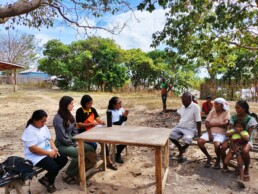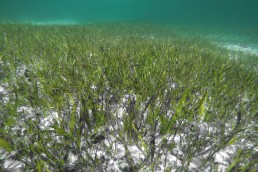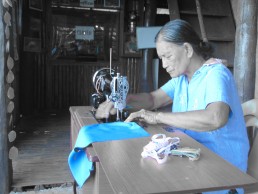Darwin Initiative 
Replicating a successful model to develop a network of Indigenous Marine Managed Areas
The Calamian Islands in the Philippines are home to numerous endangered marine species and the last remaining members of the Tagbanua tribe. This area is a center for both marine and biocultural diversity. This project funded by the UK Biodiversity Challenge Fund's Darwin Initiative aims to establish six Indigenous-Marine-Managed-Areas (IMMAs) in the Calamianes to protect these resources.
The project aims to conduct research into traditional knowledge and beliefs of the Tagbanua tribe, and how this influences their management of coastal resources. The project uses social and behavioral science research approaches to determine a pathway between traditional and scientific ecological knowledge, which can benefit the marine environment and local communities. This approach will be applied to each of the six IMMAs, and policy recommendations will be compiled for inclusion in each IMMA management plan.
Communities will receive training in marine ecology and cultural heritage for sustainable development, including threats and consequences of destructive activities and alternative livelihoods. The project will focus on fisherfolk, with an equal emphasis on men and women to enable behavior change. Local Government Units and Barangay councils will be trained to co-develop marine resource management plans and create the necessary legislation and enforcement activities. The project will use social marketing techniques, such as the book ‘Diwa the Dugong’, to train fisherfolk to assist in monitoring the IMMA, reporting infractions and recording evidence on their mobile phones. The project will also facilitate exchanges between the proposed IMMAs and existing sites at Caluauit and others to create a strong network and allow experiences and successes to be shared.
The project will establish a center for Tagbanua handicraft in Coron and develop online marketing. Local women will receive training in quality control, ensuring that they can earn the maximum possible income from their handicrafts. This will improve local wellbeing and empowerment, community resilience, and reduce dependence on fisheries for income, providing a safety net for the poorest families when fishing is not possible.
Marine Protected Areas (MPAs) are widely used for biodiversity conservation, increased fisheries productivity, and protection of cultural diversity. However, the establishment of MPAs can affect local communities, particularly those who rely heavily on marine ecosystems. This is especially important in areas where conservation areas coincide with indigenous territories. In fact, 80 % of the world's biodiversity areas overlap with ancestral lands and waters of indigenous communities.
In the Philippines, the island of Palawan is home to several marine protected areas and ancestral domains, including the Calamian group of islands. These islands have diverse and rich ecosystems, including coral reefs, seagrass and mangrove forests, serving as habitats for endangered marine species such as sea turtles, dugongs, and marine crocodiles. However, some conservation initiatives inadequately consider the area’s considerable biocultural heritage personified by the Tagbanua tribe. This creates an obstacle to effective implementation and integration of potential conservation measures. The proposed project aims to address this problem by working alongside other initiatives and filling the biocultural gap, contributing to the wider needs of the Calamianes.The project has been designed to contribute directly to the following targets in the Philippines’ National Biodiversity Strategy and Action Plan (NBSAP):
Target 3: By 2028, there will be no net loss in the presence and area distribution of live coral cover, mangroves, and seagrasses.
Target 8: By 2028, fish stocks of economically important species will be maintained.
Target 9: By 2028, there will be an annual increase of at least 5% in biodiversity conservation-related jobs such as ecotourism, sustainable agriculture, and ecosystem restoration.
Target 12: By 2028, capacity for biodiversity conservation of public and private sector groups in terrestrial and marine protected areas (PAs) and KBAs will be strengthened.
Target 20: By 2028, there will be a 20% increase from 2015 levels in the coverage of established marine protected areas (MPAs)/sanctuaries across various aquatic habitats.
The project’s focus on the marine environment directly supports Goal 14 (Life Below Water) of the Sustainable Development Goals (SDGs). This is achieved through efforts to address threats such as overfishing, habitat degradation, and loss of blue carbon sinks.
Furthermore, the project indirectly supports Goal 1 (No Poverty) by diversifying livelihoods in communities that are currently highly dependent on a single unsustainable livelihood, which is fishing. By creating alternative income-generating activities that are sustainable, the project aims to reduce poverty and improve the economic well-being of the communities in the Calamianes.

Related Case Studies
Contact C3 Philippines
Busuanga OfficeSalvacion, Busuanga, Palawan, 5317 Philippines
Taytay Field OfficePurok 6 San Lorenzo, PoblacionTaytay, Palawan, 5312 Philippines
C3 Philippines (C3PHILIPPINES INC.), in accordance with the Corporation Code of the Philippines, is registered as a non-profit organization in the Philippines under the Securities and Exchange Commission with Company Registration No. CN201115227.



